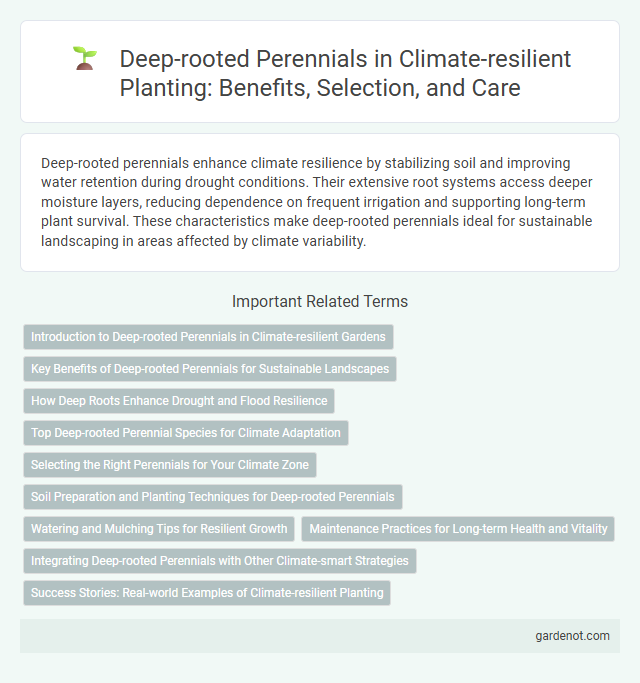Deep-rooted perennials enhance climate resilience by stabilizing soil and improving water retention during drought conditions. Their extensive root systems access deeper moisture layers, reducing dependence on frequent irrigation and supporting long-term plant survival. These characteristics make deep-rooted perennials ideal for sustainable landscaping in areas affected by climate variability.
Introduction to Deep-rooted Perennials in Climate-resilient Gardens
Deep-rooted perennials enhance climate-resilient gardens by stabilizing soil and improving water retention during droughts. Their extensive root systems penetrate deep into the earth, accessing moisture unavailable to shallow-rooted plants, which supports sustained growth under climate stress. Incorporating species like switchgrass and Jerusalem artichoke boosts ecosystem resilience and biodiversity in changing environmental conditions.
Key Benefits of Deep-rooted Perennials for Sustainable Landscapes
Deep-rooted perennials enhance soil stability by preventing erosion and improving water infiltration, which supports drought resilience in sustainable landscapes. Their extensive root systems sequester carbon effectively, contributing to climate change mitigation. These plants also promote biodiversity by providing habitats and food sources for a range of pollinators and soil organisms.
How Deep Roots Enhance Drought and Flood Resilience
Deep-rooted perennials enhance drought resilience by accessing moisture from deep soil layers unavailable to shallow-rooted plants, ensuring sustained hydration during extended dry periods. Their extensive root systems improve soil structure and increase water infiltration, reducing surface runoff and mitigating flood impacts. By stabilizing soil and maintaining ecosystem balance, deep-rooted perennials contribute significantly to climate-resilient planting strategies.
Top Deep-rooted Perennial Species for Climate Adaptation
Deep-rooted perennial species like Vetiver grass, Switchgrass, and Miscanthus offer exceptional climate adaptation benefits due to their extensive root systems that enhance soil structure and water retention. These species improve drought resilience and reduce soil erosion, making them vital for sustainable land management in changing climates. Their carbon sequestration capabilities further contribute to mitigating greenhouse gas effects while supporting ecosystem stability.
Selecting the Right Perennials for Your Climate Zone
Deep-rooted perennials enhance soil stability and improve water retention, making them ideal for climate-resilient planting in diverse regions. Selecting species native to your USDA Hardiness Zone ensures plants establish robust root systems capable of withstanding droughts, floods, and temperature fluctuations. Prioritize perennials like Echinacea purpurea or Asclepias tuberosa, known for deep roots and adaptability, to promote long-term ecosystem resilience.
Soil Preparation and Planting Techniques for Deep-rooted Perennials
Effective soil preparation for deep-rooted perennials involves deep tilling to improve aeration and drainage, ensuring the soil profile supports extensive root growth. Incorporating organic matter such as compost enhances soil structure and nutrient availability, promoting robust root development critical for climate resilience. Proper planting techniques include spacing to reduce competition and planting at the correct depth to encourage deep root expansion, enabling plants to access water from lower soil layers during droughts.
Watering and Mulching Tips for Resilient Growth
Deep-rooted perennials enhance climate resilience by accessing deeper soil moisture, reducing the frequency of watering required. Mulching around these plants conserves soil moisture, regulates temperature, and suppresses weed growth, promoting healthier root development. Implementing watering schedules that allow the soil to dry slightly between sessions prevents root rot and encourages deeper root expansion.
Maintenance Practices for Long-term Health and Vitality
Deep-rooted perennials require minimal but consistent maintenance practices to ensure their long-term health and vitality in climate-resilient planting. Regular mulching conserves soil moisture and suppresses weeds, while periodic deep watering promotes expansive root development essential for drought resistance. Monitoring soil health and applying organic compost supports nutrient cycling, enhancing the plant's resilience against extreme weather conditions.
Integrating Deep-rooted Perennials with Other Climate-smart Strategies
Integrating deep-rooted perennials with climate-smart agriculture enhances soil carbon sequestration and improves water infiltration, creating resilient agroecosystems. These perennials work synergistically with cover crops and reduced tillage to stabilize soils and mitigate drought impacts. Combining diverse plant species with deep-rooted perennials boosts ecosystem services, promoting long-term agricultural sustainability under changing climate conditions.
Success Stories: Real-world Examples of Climate-resilient Planting
Deep-rooted perennials like vetiver grass and switchgrass have demonstrated remarkable success in climate-resilient planting by enhancing soil stability and water retention in drought-prone regions. Projects in Sub-Saharan Africa reveal that integrating these species reduces erosion by up to 70% and improves crop yields under erratic rainfall patterns. These real-world examples underscore the critical role of deep-rooted perennials in sustainable agriculture and climate adaptation strategies.
Deep-rooted perennial Infographic

 gardenot.com
gardenot.com